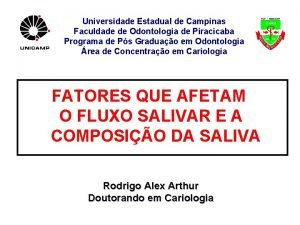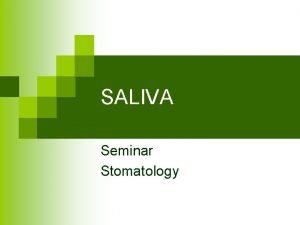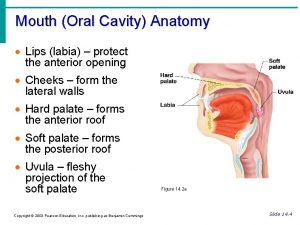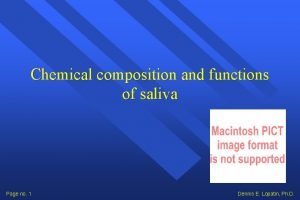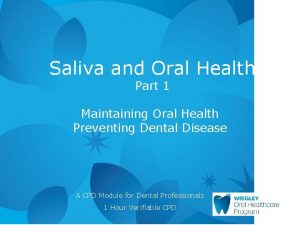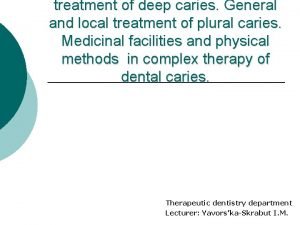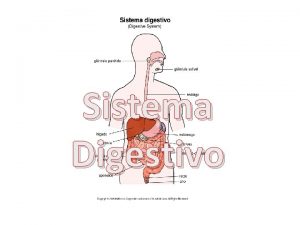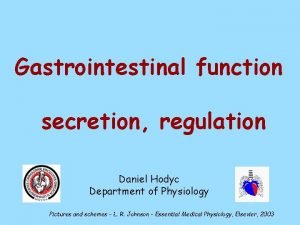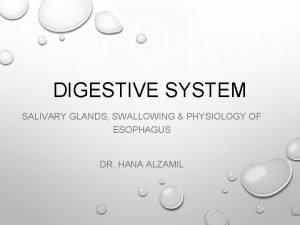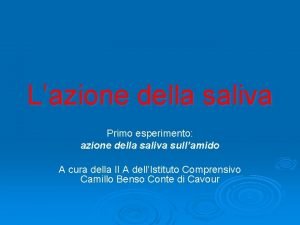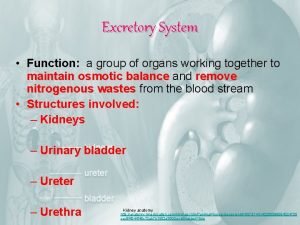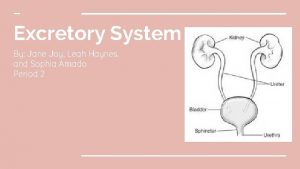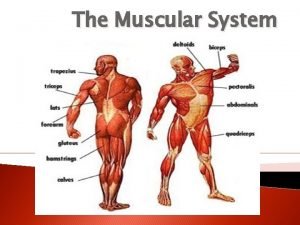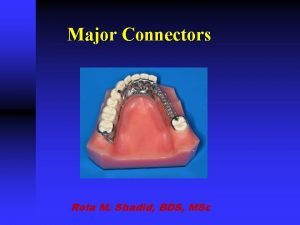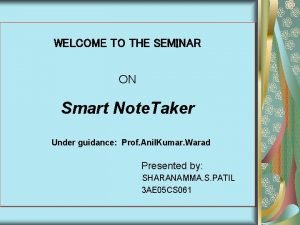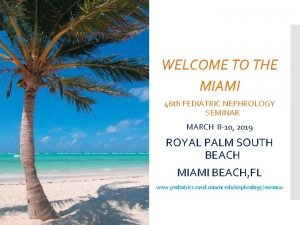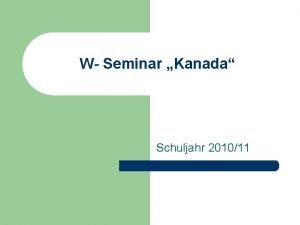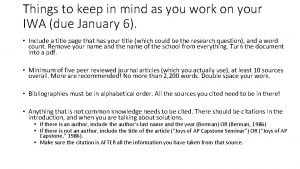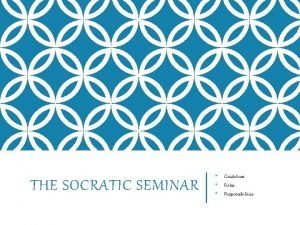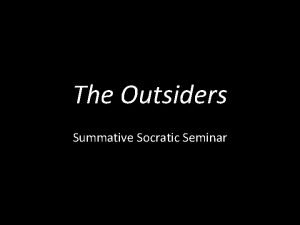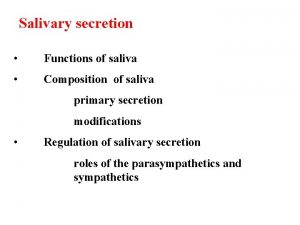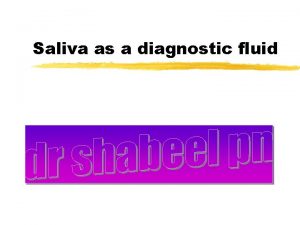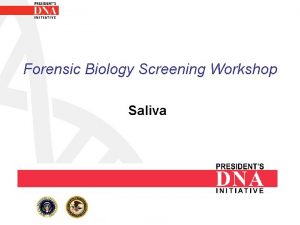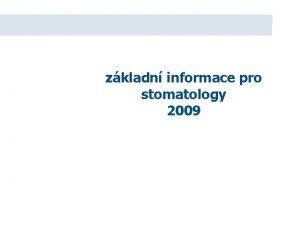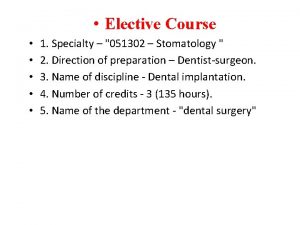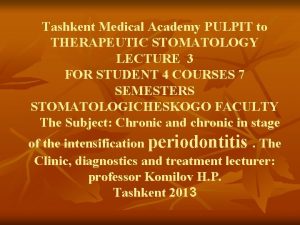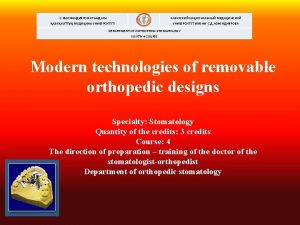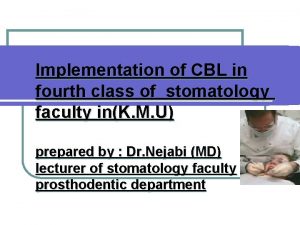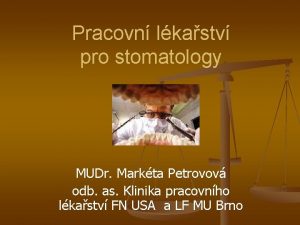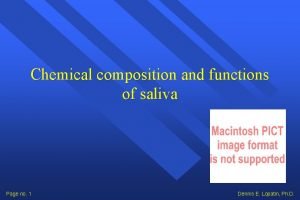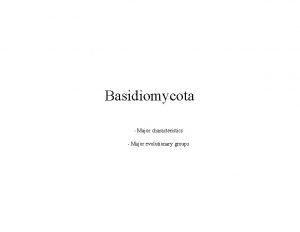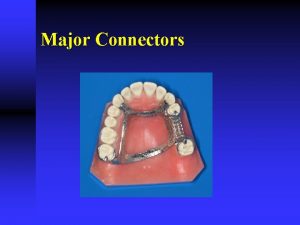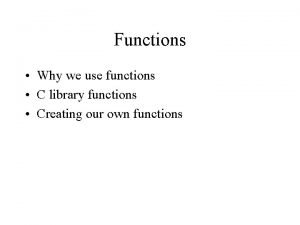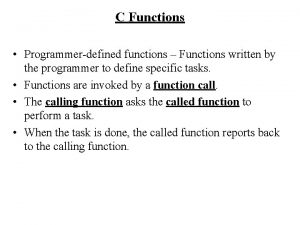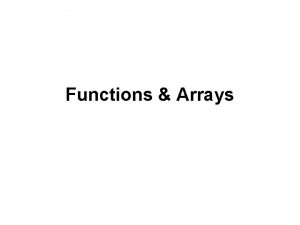SALIVA Seminar Stomatology MAJOR FUNCTIONS OF SALIVA n































- Slides: 31

SALIVA Seminar Stomatology

MAJOR FUNCTIONS OF SALIVA n n n n n Solvent Buffering Lubrication Remineralization Digestion Anti-bacterial Anti-fungal Temperature regulation Production of growth factors and other regulatory peptides

A CONSIDERABLE VOLUME OF SALIVA IS PRODUCED OVER A DAY n n 0. 5 to 1. 5 liter of fluid is secreted in a day This represents about 1/5 of the total plasma volume This fluid is not lost as most of it is swallowed and reabsorbed by the gut Parotis, submandibularis, sublingualis

THE SECRETORY UNIT The basic building block of all salivary glands n ACINI - water and ions derived from plasma n Saliva formed in acini flows down DUCTS to empty into the oral cavity.

TWO STAGE HYPOTHESIS OF SALIVA FORMATION Most proteins Water & electrolytes Na+ Cl- resorbed Some proteins Isotonic primary saliva electrolytes K+ secreted Hypotonic final saliva into mouth

Inorganic components Saliva compositon

Calcium and phosphate n n Help to prevent dissolution of dental enamel Calcium ¨ 1, 4 mmol/l (1, 7 mmol/l in stimulated saliva) ¨ only cca 50% in ionic form ¨ sublingual > submandibular > parotis n Phosphate ¨ 6 mmol/l (4 mmol/l in stimulated saliva) ¨ 90% in ionic form n n p. H around 6 - hydroxyapatite is unlikely to dissolve Increase of p. H - precipitation of calcium salts => dental calculus

Hydrogen carbonate Buffer n Low in unstimulated saliva, increases with flow rate n Pushes p. H of stimulated saliva up to 8 n p. H 5, 6 critical for dissolution of enamel n Defence against acids produced by cariogenic bacteria n Derived actively from CO 2 by carbonic anhydrase n

Other ions n Fluoride ¨ Low n concentration, similar to plasma Thiocyanate ¨ Antibacterial (oxidated to hypothiocyanite OSCN- by active oxygen produced from bacterial peroxides by lactoperoxidase) ¨ Higher conc. => lower incidence of caries ¨ Smokers - increased conc. n n Sodium, potassium, chloride Lead, cadmium, copper ¨ May reflect systemic concentrations - diagnostics

FLOW RATE ml/min Concentration (m. M)

Organic components Saliva composition

Organic components of saliva n n n Mucins Proline-rich proteins Amylase Lipase Peroxidase Lysozyme Lactoferrin s. Ig. A Histatins Statherin Blood group substances, sugars, steroid hormones, amino acids, ammonia, urea

Multifunctionality Amylases, Cystatins, Carbonic anhydrases, Histatins, Mucins, Histatins Anti. Peroxidases Buffering Bacterial Amylases, Cystatins, Mucins, Lipase Anti. Mucins Digestion Viral Salivary Functions Mineral. Antiization Fungal Cystatins, Histatins, Proline. Lubricat. Tissue ion &Viscorich proteins, Coating elasticity Statherins Amylases, Cystatins, Mucins, Statherins Proline-rich proteins, Statherins adapted from M. J. Levine, 1993

Mucins Lubrication n Glycoproteins - protein core with many oligosaccharide side chains attached by Oglycosidic bond n More than 40% of carbohydrates n Hydrophillic, entraining water (resists dehydration) n Unique rheological properties (e. g. , high elasticity, adhesiveness, and low solubility) n Two major mucins (MG 1 and MG 2) n

Amylases n n n n Calcium metalloenzyme Hydrolyzes (1 -4) bonds of starches such as amylose and amylopectin Several salivary isoenzymes Maltose is the major end-product (20% is glucose) Parotis; 30% of total protein in parotid saliva “Appears” to have digestive function - inactivated in stomach, provides disaccharides for acid-producing bacteria Why is it also present in tears, serum, bronchial, and male and female urogenital secretions? A role in modulating bacterial adherence?

Lingual Lipase Secreted by lingual glands and parotis n Involved in first phase of fat digestion n Hydrolyzes medium- to long-chain triglycerides n Important in digestion of milk fat in new-born n Unlike other mammalian lipases, it is highly hydrophobic and readily enters fat globules n

Statherins Calcium phosphate salts of dental enamel are soluble under typical conditions of p. H and ionic strength n Supersaturation of calcium phosphates maintain enamel integrity n Statherins prevent precipitation or crystallization of supersaturated calcium phosphate in ductal saliva and oral fluid n Produced by acinar cells in salivary glands n Also an effective lubricant n

Proline-rich Proteins (PRPs) 40% of AAs is proline n Inhibitors of calcium phosphate crystal growth n Part of pellicula dentis n Subdivided into three groups n ¨ Acidic 45% ¨ Basic 30% ¨ Glycosylated 25%

Lactoferrin Iron-binding protein n „Nutritional“ immunity (iron starvation) n Some microorganisms (e. g. , E. coli) have adapted to this mechanism by producing enterochelins. n ¨ bind iron more effectively than lactoferrin ¨ iron-rich enterochelins are then reabsorbed by bacteria n Lactoferrin, with or without iron, can be degraded by some bacterial proteases.

Lysozyme Present in numerous organs and most body fluids n Also called muramidase n hydrolysis of (1 -4) bond between Nacetylmuramic acid and Nacetylglucosamine in the peptidoglycan layer of bacteria. n ¨ Gram negative bacteria generally more resistant than gram positive because of outer LPS layer

Histatins A group of small histidine-rich proteins n Potent inhibitors of Candida albicans growth n

Cystatins n n n Are inhibitors of cysteine-proteases Are ubiquitous in many body fluids Considered to be protective against unwanted proteolysis ¨ bacterial proteases ¨ lysed leukocytes n n May play inhibit proteases in periodontal tissues Also have an effect on calcium phosphate precipitation

Salivary peroxidase systems n Sialoperoxidase (SP, salivary peroxidase) ¨ Produced in acinar cells of parotid glands ¨ Also present in submandibular saliva ¨ Readily adsorbed to various surfaces of mouth n n enamel, salivary sediment, bacteria, dental plaque Myeloperoxidase (MP) ¨ From leukocytes entering via gingival crevice ¨ 15 -20% of total peroxidase in whole saliva

CIRCAIDIAN RHYTHM OF SALIVA FLOW 30 No sleep 20 10 sleep n 12 am 6 am 12 pm 6 pm 12 am 6 am Time of day 12 pm 6 pm 12 am 24

Effect of feeding on salivary secretion Meal during this period 10 min collection periods 25

Variations in salivary composition n Unstimulated flow ¨ Submandibular g. 70% ¨ Parotid g. 20% ¨ Accesory g. 7% ¨ Sublingual 2% n Acid stimulation ¨ Submandibular ¨ Parotid n g. 45% Chewing ¨ Submandibular ¨ Parotid g. 60% g. 30%

Variations in salivary composition Parotid secretion increased amylase content n Submandibular secretion increased calcium concentrations n

Gingival cervicular fluid Seminar Stomatology

Gingival cervicular fluid n Synonyms: ¨ Gingival fluid ¨ Cervicular fluid ¨ Sulcular fluid Similar composition as interstitial fluid n Flow rate related to degree of gingival inflamation, circa 0, 5 -2, 4 ml/day n

Composition n Cells Desquamated epithelial cells ¨ Neutrophils ¨ Small amount of lymphocytes and monocytes ¨ Bacteria ¨ n Inorganic ions Similar to plasma ¨ Potassium 2 x higher than in plasma (cell break-up) ¨ Calcium higher than in oral fluid ¨ n Organic components Similar to plasma - serum albumin, globulins, complement, protease inhibitors ¨ Small organic molecules - lactate, urea, hydroxyproline ¨ Enzymes ¨

Function Protective flow towards oral cavity washes out potentially harmful cells and molecules n Antibacterial - immunoglobulins n Calcium assists pellicle and plaque fromation but may contribute to calculus formation n Rather response to inflamation n
 Composicao da saliva
Composicao da saliva What are the main components of saliva
What are the main components of saliva Funtions of saliva
Funtions of saliva Properties of saliva
Properties of saliva Parasympathetic nervous system
Parasympathetic nervous system Saliva formation
Saliva formation Over trituration of amalgam
Over trituration of amalgam Partes de la boca interna
Partes de la boca interna Acid secretion
Acid secretion Saliva formation
Saliva formation Oracol saliva collection system
Oracol saliva collection system Esperimento saliva tintura di iodio
Esperimento saliva tintura di iodio Excretory system functions
Excretory system functions 5 facts about the excretory system
5 facts about the excretory system 7 management functions
7 management functions A computer system consists of both hardware and software.
A computer system consists of both hardware and software. Muscular syst
Muscular syst Function of commercial bank is
Function of commercial bank is Single palatal strap
Single palatal strap Swing-lock major connector
Swing-lock major connector Absolute value function to piecewise function
Absolute value function to piecewise function Evaluating functions and operations on functions
Evaluating functions and operations on functions Evaluating functions and operations on functions
Evaluating functions and operations on functions What makes a good college application
What makes a good college application Conclusion of smart note taker
Conclusion of smart note taker Miami pediatric nephrology seminar
Miami pediatric nephrology seminar Ap seminar memes
Ap seminar memes W seminar präsentation
W seminar präsentation Buck boost transformer seminar report
Buck boost transformer seminar report Minimum word count for iwa
Minimum word count for iwa Socratic
Socratic Sentence starters for socratic seminar
Sentence starters for socratic seminar
